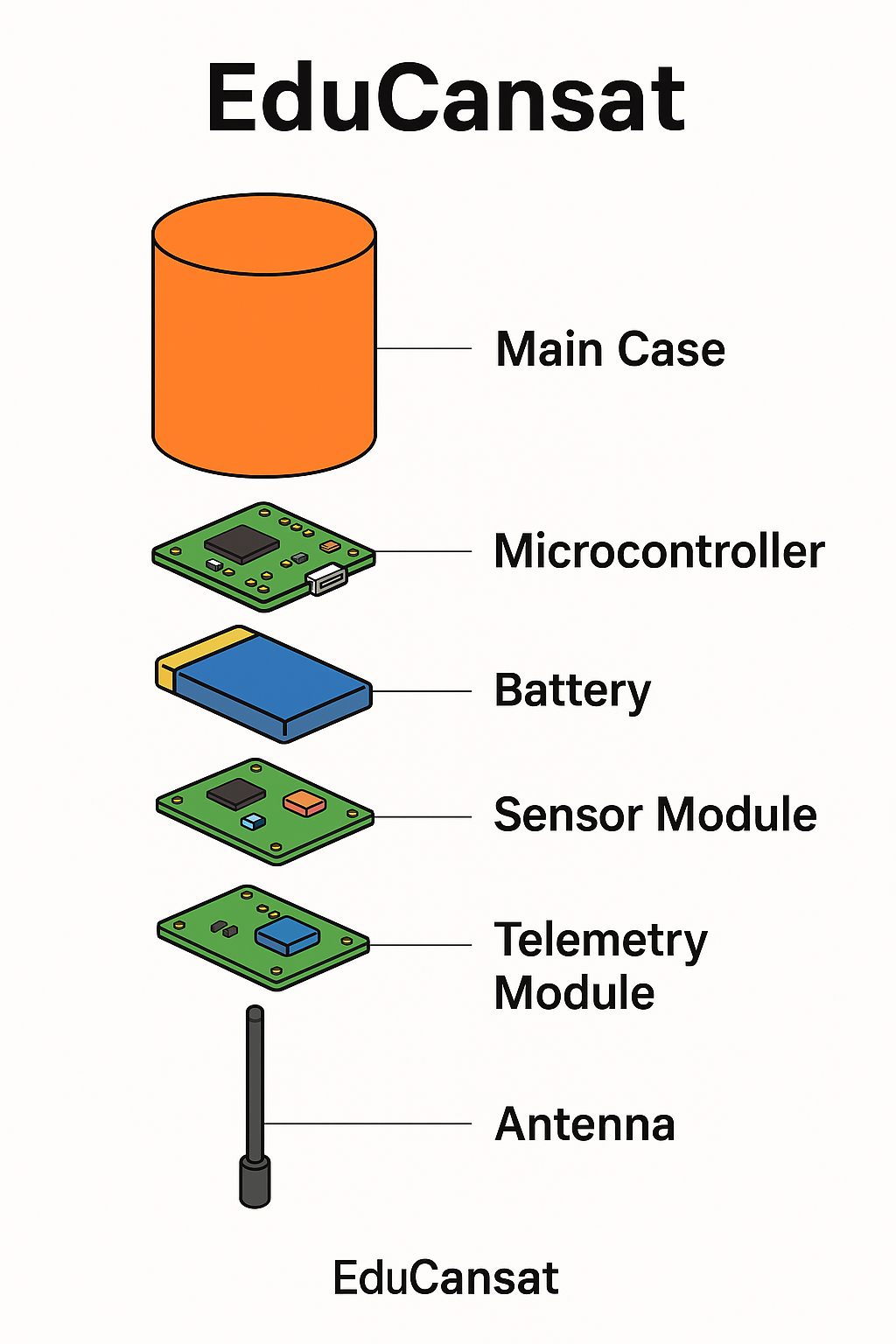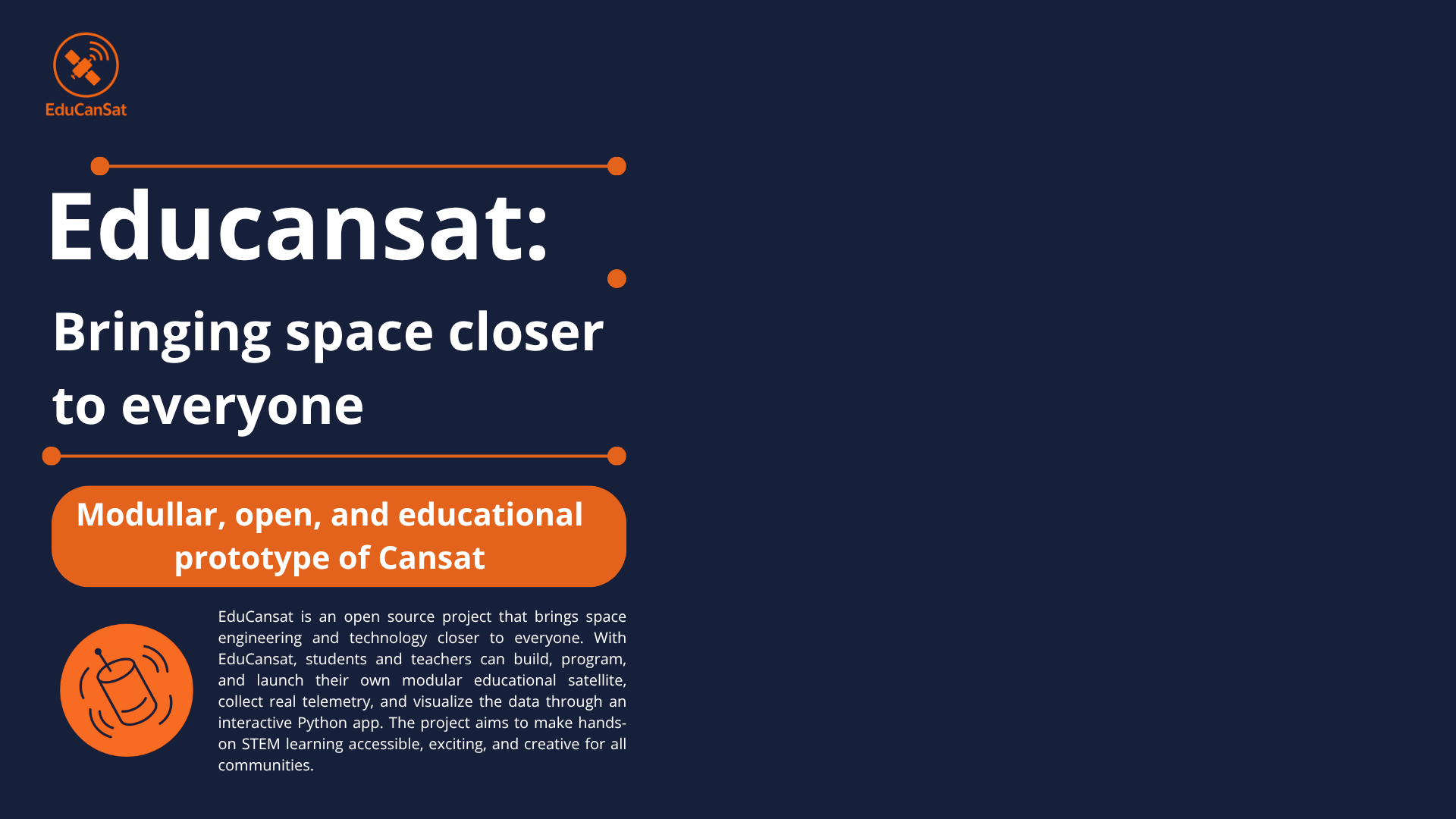Week 18
Invention, Intellectual Property and Income
Introduction
For this week, I worked on the “Invention, Intellectual Property, and Income” assignment, which centers on how to present and share my final project, EduCansat, with a broader audience. The goal was to design a realistic dissemination plan, clarify the open-source licensing, and prepare key materials for Fab Academy: a summary slide and a short presentation video. These resources highlight EduCansat’s mission to make hands-on STEM and space engineering accessible, modular, and inspiring for students, teachers, and communities everywhere.
About EduCansat

EduCansat is an educational CanSat prototype designed to make aerospace engineering and electronics accessible and exciting for students, teachers, and rural communities. The main goal of EduCansat is to bring real engineering experiences into the classroom and beyond, using affordable, modular hardware that anyone can build, modify, and deploy.
This project is all about learning by doing. With EduCansat, students can assemble their own satellite, add different sensors or modules, and launch it from high places — like the tenth floor of Universidad Ean — or even from balloons. After the launch, all the data is transmitted in real time and can be visualized on a map using the Python application we developed, making data analysis both interactive and fun.
EduCansat is completely open source and released under the MIT License. That means you are free to use, modify, share, and improve every part of the project — hardware, software, and documentation — as long as you give proper credit. My intention is to empower teachers, organize workshops and bootcamps, and collaborate with schools and rural communities, helping more people get excited about engineering and technology.
- Modular design: Easily add or swap sensors and components.
- Affordable and reproducible: Uses low-cost, widely available parts.
- Real-world experience: Simulate satellite missions, collect and analyze data.
- Visual and interactive: View live telemetry and sensor data on a map.
- Community-driven: Built to be shared, adapted, and improved by anyone.
My vision with EduCansat is to inspire students to discover STEM through hands-on challenges and real missions, building a bridge between theory and practice, and opening the doors of aerospace to everyone.
Everything in this project — code, hardware files, and documentation — is licensed under the MIT License.
EduCansat: The big picture
Below you’ll find the main slide that I prepared to present my EduCansat prototype. This summarizes the core of the project and what makes it unique. If you’re interested in the technical details, assembly steps, or educational resources, you can explore the other sections of this documentation.

EduCansat Project Video
Below you’ll find a short video that summarizes the essence of my EduCansat project. This video was created using AI tools to visually communicate the main features, educational impact, and hands-on spirit of the prototype. For more technical details and the complete development process, please check out the rest of this documentation.
Dissemination Plan
My main goal is to make EduCansat accessible to as many people as possible, especially students, teachers, and communities with limited resources. Here’s how I plan to share and expand the project:
- Fab Academy and Open Documentation: All the development steps, instructions, files, and guides are freely available on my Fab Academy documentation.
- Workshops and Bootcamps: I will organize hands-on workshops and bootcamps with schools, teachers, and rural communities, helping participants build and launch their own EduCansat and learn by doing.
- Collaborations with Schools: I’m working with local schools and teachers to create custom educational experiences, classroom kits, and open lesson plans using EduCansat.
- Community Outreach: I plan to share the project through online platforms like GitHub, social media, and maker forums, inviting others to remix, translate, and adapt EduCansat to their own contexts.
- University and Science Fairs: I will continue to present and demonstrate EduCansat at events, including launches from tall buildings at Universidad Ean to inspire more students to get involved.
- Educational Content: I’m preparing step-by-step guides, video tutorials, and challenges to help teachers and students integrate EduCansat into their STEM programs.
I believe that by sharing everything openly and making it as easy as possible to replicate, EduCansat can help lower barriers and bring space science to everyone, everywhere.
To make EduCansat accessible and engaging for everyone, I am developing an illustrated handbook that guides users through every step of building, programming, and launching their own CanSat. The handbook will include:
- Colorful diagrams and simple explanations of every module and function.
- All the source code, with annotated examples and tips.
- Mini-tasks and challenges after each section, so anyone—student, teacher, or hobbyist—can learn by doing and customize their own EduCansat.
This resource will be freely available, open source, and updated with new activities as the community grows.
The illustrated cover below was generated using ChatGPT (DALL·E) to visually represent the EduCansat handbook. This visual resource helps communicate the playful and educational spirit of the project, making it accessible and engaging for all audiences.

Illustrated handbook: Step-by-step guide for creative exploration with EduCansat.
Key Features of EduCansat

- Modular Design: Swap sensors, microcontrollers, and components easily to explore new experiments and challenges.
- Accessible and Affordable: All parts are low-cost and widely available, making EduCansat suitable for classrooms, clubs, and remote communities.
- Real-World Missions: Perform actual launches from tall buildings or balloons, collect real telemetry and sensor data, and analyze results just like a space mission.
- Python Application: The custom Python app displays live data on an interactive map, helping students connect coding with real-world engineering.
- Hands-On STEM Learning: EduCansat helps students understand physics, engineering, electronics, programming, and data analysis through direct experience.
- Open and Adaptable: Anyone can modify, extend, or translate the project to suit local needs, from classroom lessons to advanced maker challenges.
Get Involved / Community
I invite you to use, adapt, and share EduCansat in your own learning environments! Whether you are a teacher, student, or community leader, you can:
- Build your own EduCansat and try new experiments.
- Organize workshops or classroom challenges.
- Translate or remix the materials for your community.
- Share your results, modifications, or stories with me and the wider community — I’m always excited to see how EduCansat grows and evolves!
For questions, suggestions, or to collaborate, please connect through my Fab Academy page.